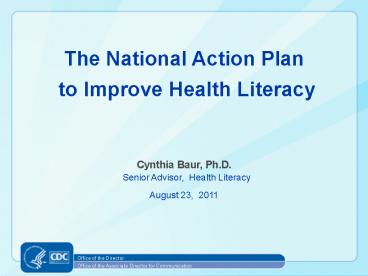Cynthia Baur, Ph.D. - PowerPoint PPT Presentation
Title:
Cynthia Baur, Ph.D.
Description:
Office of the Associate Director for Communication ... – PowerPoint PPT presentation
Number of Views:110
Avg rating:3.0/5.0
Title: Cynthia Baur, Ph.D.
1
The National Action Plan to Improve Health
Literacy
- Cynthia Baur, Ph.D.
- Senior Advisor, Health Literacy
- August 23, 2011
- Office of the Director
- Office of the Associate Director for Communication
2
Key Messages
Government agencies, foundations, and research
universities should prioritize funding for
qualitative and quantitative studies related to
health literacy improvement. Goal 6, National
Action Plan Funders play a critical role in the
dissemination and use of research
findings. Goal 7, National Action Plan
3
What is the Gap?
4
- Health Literacy Hearing the voices of people on
the receiving end of our communication
5
What is a 2 times greater risk for pneumonia if I
dont get a flu shot? Greater than what?
6
What do these survival rates mean for me? 80
8 of 10 women? 80 of 100? .8? Is one better
than the other?
7
What is Health Literacy?
- Obtain
- Process
- Understand
- Decide
Health Information and Services
- Sources National Library of Medicine, Healthy
People
8
How is Health Literacy Different from General
Literacy?
- Builds on literacy skills BUT ALSO
- Cultural and contextual factors
- Beliefs, experience and preferences
- Topic area and conceptual knowledge, such as
- knowledge of the body and how it works
- terms for specific health conditions
- scientific results and risk
9
Institute of Medicine Report on Health Literacy
- Limited health literacy is a major public health
issue - Interaction of individual skills and social
complexity creates health literacy problems - Professionals need health literacy training
10
Health Literacy Dynamic
11
Literacy in AmericaNational Assessment of Adult
Literacy (NAAL)
- National sample survey conducted in 1992 and 2003
- Performed by U.S. Department of
Education,National Center for Health Statistics - In-person interviews with Americans age 16 and
older (N19,000) - Tested in English or alternate short test in
Spanish - Over sampling of Blacks and Hispanics
- http//nces.ed.gov/naal/
12
NAAL Domains
- Emphasized the use of printed everyday materials
(newspapers, prescriptions, bills) needed to
function - 153 items that assessed prose, document, or
quantitative literacy - Most items required searching text for specific
information, short written responses
- http//nces.ed.gov/naal/
13
Categories and Sample Health Tasks
- Proficient Calculate employees share of health
insurance costs for a year - Intermediate Determine healthy weight range
medication timing - Basic Explain why it is difficult to know if
they have a specific chronic condition - Below Basic Identify what is permissible to
drink before a medical test
- http//nces.ed.gov/naal/
14
Results from the NAAL
12
Proficient
13
Below Basic
53
Intermediate
Basic
22
77 Million Adults have Basic or Below Basic
Health Literacy
- Kutner et al. National Assessment of Adult
Literacy, 2006
15
Health Literacy by Age
59
- Kutner et al. National Assessment of Adult
Literacy, 2006
16
Health Literacy by Race/Ethnicity
- Kutner et al. National Assessment of Adult
Literacy, 2006
17
Health Literacy by Education
- Kutner et al. National Assessment of Adult
Literacy, 2006
18
Outcomes Associated with Limited Health Literacy
- Health outcomes
- Taking medications appropriately
- Interpreting labels and health messages
- Seniors health status and quality of life
- Mortality
- Health services
- Hospitalization
- Emergency care visit
- Flu immunization
- Knowledge and comprehension
- Berkman et al 2011 Health Literacy Interventions
and Outcomes An Updated Systematic Review
19
Why A National Action Plan?
20
What is the Plan?
21
Seven Goal Areas
- Health information creation and dissemination
- Healthcare services
- Early childhood-university education
- Community-based services
- Partnership and collaboration
- Research and evaluation
- Dissemination of evidence-based practice
22
HHS Health Literacy Research
- NIH/AHRQ Understanding and Promoting Health
Literacy Program Announcement (PAR-10-133) - R01, R03 and R21
- NIH 85 grants totaling 67 million (2004-2011)
- http//obssr.od.nih.gov/scientific_areas/social_cu
lture_factors_in_health/health_literacy/index.aspx
- Additional research under other Funding
Opportunity Announcements and contracts - NIH/AHRQ support of annual research conference
- http//www.bumc.bu.edu/healthliteracyconference/
23
Ideas for research and intervention topics
- NIH/AHRQ Program Announcement
- National Action Plan Goals
- Research presented at annual conference
- AHRQ systematic review
- http//www.ahrq.gov/clinic/tp/lituptp.htm
- Evaluation of tools
- Organizational audits
- Universal precautions in clear communication
- Clear communication training
- Standards
24
Call to Action
- The National Action Plan to Improve Health
Literacy challenges individuals, organizations
and communities to fulfill their responsibility
to make - health information and services
- ACCURATE, ACCESSIBLE AND ACTIONABLE
25
A Challenge
- Is your foundation using its resources to
- improve health literacy OR
- perpetuate and create health literacy barriers?
26
- What questions do you have?
- www.cdc.gov/healthliteracy
- http//blogs.cdc.gov/healthliteracy/
- Office of the Director
- Office of the Associate Director for Communication































